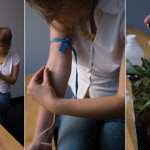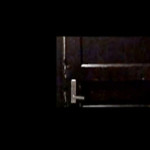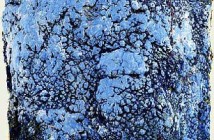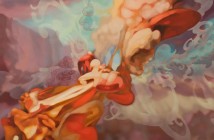AND THINGS OF THAT NATURE @ BCA
The students in the MIT Visual Studies graduate program are not really conventional artists. These individuals are engaged in scientific, social, political and ethical questions expressed in a visual form, in the context of the cutting-edge technology available at the Institute. Emphasizing inquisitive and avant-garde techniques, this art is a means of research and knowledge in and of itself. In the new exhibition, And Things of That Nature, we are able to get a peak at the work being done by the current graduate students, as well as some information about future ideas for works in process that are forthcoming.
In two video installations by Jaekyung Jung, issues of social norms are questioned with simple but provocative techniques. In Hit Here if You Feel Victimized, Jung films a collaborator walking through the street of Boston wearing a large drum strung around their neck that bears this message. Inviting passers-by on the street to bang the drum, we engage in a strange multi-faceted interaction. There is a sense of camaraderie in the act of releasing frustration through a universal and common sentiment. Yet at the same time, Jung’s collaborator (a sweet and approachable Sohin Hwang) is on the receiving end of this aggression in some way. Human interaction calls for propriety of being reserved and saving aggression for sports or the dark, hidden side of our nature. This experiment loosens the rules of engagement, and reveals something about each individual who participates in the experiment.
Jaekyung Jung creates a different sense of discomfort with her other film installation which features a simple mirror experiment. The installation itself also has a reflective and disorienting feeling to it, which is appropriate for the reflection quality of the project. The film of Jung’s excursions plays on two opposing walls simultaneously, creating the double image effect for the viewer’s experience. The film depicts imagery of Jung wearing a mirror over her face and body wandering the streets, seeing the reactions it elicits out of pedestrians. The gesture is simple yet extremely confrontational in the context of social norms. Jung also films mirrors attached to the exterior of a van driving through the city streets, capturing an image that initially seems alarming and unsafe. Particularly fascinating is the mirror experiment in the context of Jung riding the T, because the train is one place where social etiquette tends to be avoidance, aloofness and introversion. Being confronted with our own image is forcefully interactive and highly counter-cultural.
Caitlin Berrigan’s work explores human interaction in a much more visceral way. Her video and installation play with the notion of interpersonal relationships in the context of contamination and an expanding biomedical economy. In one black and white film, two female subjects choreograph a physical connection that intrigues the eye. One woman takes a drink of milk from a large pitcher, kisses her partner, and in this act disseminates the milk into her mouth. In a perfectly complimentary fashion, the female partner spits out the milk into her own pitcher. The entire exchange is done calmly and gracefully in slow motion, which creates a strange juxtaposition of repulsion and fascination. The intimate screen is set back in the wall and only measures a few inches in perimeter, which is perfect for creating a voyeuristic feeling. While spitting the milk and sharing the fluid raises concerns about germs and contamination, the film is orchestrated to be visually beautiful. The two women are attractive and their act is so poised that you don’t fully grasp how they’ve choreographed this synchronized act.
Berrigan’s other installation at the exhibition is a plant growing out of soil that has been nourished with her own human blood. Images of Berrigan finding a vein and drawing her own blood are along the wall of the exhibition. Her objective is to create a sense of unease about the fears of human blood in the context of contagious disease and cleanliness. Considering how science has advanced, and human beings have transfusions and organ donations to save their own lives, the commentary is an appropriate metaphor for her point. However, while the idea is intellectually provocative, it doesn’t have the same visual impact as her film. We feel a step removed from her plants, which appear completely normal and disconnected to their non-traditional nutritional origins. Physically, the plants even sit in their own sills and do not really feel connected to the visceral reaction that Berrigan is reaching for.
One highly interactive piece of the exhibition is a virtual memory created between artist Jin Jung and the viewer, which takes the form of a small book that is constructed throughout your gallery visit. Once you pick up the binding, containing page one, you are invited to write this “play” which is quite literally a game, rather than a theatrical play. You begin by stamping the cardboard cover with a title that leaves space to be personalized with the by-line, as Jung considers the viewer a co-author of the experience. Each page contains a short, poetic written piece and a rough sketch enacting Jung and the viewer’s interaction on the back. Jung implores the viewer to travel through the gallery and take part in creating this “memory” of their experience together. When they gather each page, Jung says, “Look for me. You’ll find me there.”
In one “chapter” entitled can you see me? Jung is almost playing hide and seek with the viewer, recounting a moment pressed up behind a column, breathing condensation on the white surface, and waiting to be discovered by you, the counterpart. In another page, called traveling column, Jung invites the viewer to push a white column on wheels, which contains the final page to her memory book. Some of the text is a bit abstract, and the construction could be taken to a new level, but the concept is definitely interesting. Jung is trying to create unique piece of art in the experiences for each individual viewer. This piece actually sums up why I am always curious about what MIT students are up to. While the work isn’t always executed in a way that is visually conspicuous, the art tend to be very provocative conceptually, and stirs up ideas worth considering.
- Jaekyung Jung, shots from Hit Here if You Feel Victimized, 2008
- Caitlin Berrigan, shots from Life Cycle of a Common Weed, 2007-08
- Jin Jung, still from the installation of can you see me, 2009
-
Click for a slideshow of the exhibtion opening, shot by Jaekyung Jung.
"All Things of that Nature" was on view until June 7th, 2009 in the Mills Gallery at the Boston Center for the Arts, located at 539 Tremont St., Boston, MA.
All images are courtesy of the artists, the BCA, and the Mills Gallery.







